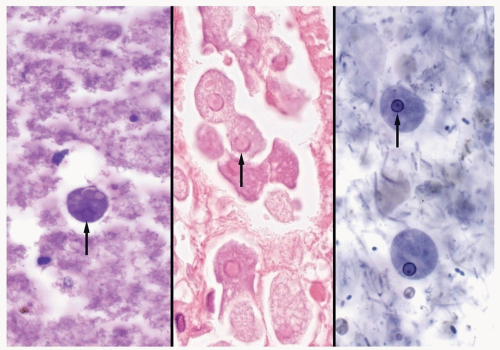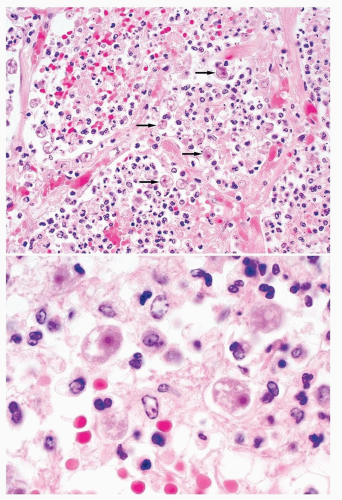Parasite |
Infection |
Pulmonary Pathology and Manifestations |
Geographic Distribution |
Ancylostoma duodenalea |
Hookworm infection |
Loeffler syndromeb |
Tropics and subtropics worldwide with poor sanitation |
Ascaris lumbricoidesa |
Ascariasis |
Loeffler syndrome,b bronchopneumonia due to larvae, rarely adult worms may migrate to trachea, lung, pulmonary artery, and pleurae |
Tropics and subtropics worldwide with poor sanitation |
Baylisascaris procyonis |
Baylisascariasis, visceral larva migrans |
Eosinophilic pneumonia: cough, dyspnea, fatigue, fever |
North America where raccoons are found |
Brugia speciesa |
Filariasis |
Tropical pulmonary eosinophiliac due to microfilariae, adult worms in pulmonary arteries cause thrombosis and occlusion |
Tropics, especially South and Southeast Asia |
Dirofilaria immitis and other Dirofilaria speciesa |
Dirofilariasis |
Pulmonary nodule, lung infarction: cough, hemoptysis, fever, chest pain |
Worldwide, including the southeastern United States |
Gnathostoma spinigerum |
Gnathostomiasis |
Bronchitis, pneumonia, cough, hemoptysis, fever, respiratory failure, chest pain, pneumothorax, pleural effusion, expectorated worm |
Southeast Asia and Mexico where insufficiently cooked fish, frog, or snake is ingested |
Mansonella perstans |
Filariasis |
Pleural cavity filariasis, microfilariae released into peripheral blood: fever |
Parts of Africa, South America |
Necator americanusa |
Hookworm infection |
Loeffler syndromeb |
Regions of the tropics and subtropics worldwide with poor sanitation |
Strongyloides stercoralisa |
Strongyloidiasis, Strongyloides hyperinfection syndrome |
Loeffler syndrome,b bronchial infiltration, secondary bacterial pneumonia: cough, dyspnea |
Tropics and subtropics worldwide with poor sanitation including southeastern United States (Appalachia) |
Trichinella spiralis and other Trichinella species |
Trichinosis, trichinellosis |
Pneumonia, respiratory failure, usually a component of disseminated disease: cough, dyspnea |
Worldwide, where insufficiently cooked flesh of carnivores (pig, boar, bear, walrus) is consumed |
Toxocara canis and Toxocara catia |
Toxocariasis, visceral larva migrans |
Eosinophilic pneumonia; cough, dyspnea, fatigue, fever |
Worldwide |
Wuchereria bancroftia |
Filariasis |
Tropical pulmonary eosinophiliac due to microfilariae, adult worms in pulmonary arteries cause thrombosis and occlusion |
Tropics, especially South and Southeast Asia |
a Most common parasites causing human disease. Other nematodes have rarely been reported to involve the lung. These include anisakiasis (infection with Anisakis spp. and Pseudoterranova decipiens) (eosinophilic pleural effusion); angiostrongyliasis (pulmonary artery thrombosis); capillariasis (Capillaria aerophila) (bronchial infection); pinworm infection (Enterobius vermicularis) (pulmonary nodules, cough, and dyspnea); halicephalobus (Halicephalobus/Micronema gingivalis aka H. deletrix) (associated with fatal encephalitis); lagochilascariasis (Lagochilascaris minor) (pulmonary nodule); and onchocerciasis (Onchocerca volvulus); and syngamosis (Mammomonogamus laryngeus) (cough, hemoptysis, worms attached to mucosa).
b Loeffler syndrome is associated with the pulmonary migration stage of certain intestinal nematodes. It is characterized by self-limited fever, dry cough, wheezing, and peripheral and tissue eosinophilia.
c Tropical pulmonary eosinophilia is a syndrome associated with infection with the filarial worms that cause lymphatic filariasis. It is characterized by chronic low-grade fever, nocturnal paroxysmal dry cough and wheezing, high peripheral and tissue eosinophilia. Microfilariae are rarely seen in tissue sections. When present, they are generally within eosinophilic necrotizing granulomas. |
Modified from Procop GW, Neafie RC. Human parasitic pulmonary infections. In: Zander DS, Farver CF, eds. Pulmonary Pathology. Philadelphia, PA: Churchill Livingstone; 2008:287-314; Kim K, Weiss LM, Tanowitz HB. Parasitic infections. In: Broaddus VS, Mason RJ, Ernst JD, et al., eds. Murray and Nadel’s Textbook of Respiratory Medicine. Philadelphia, PA: Elsevier Saunders; 2016:682-698. |





